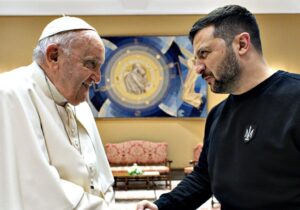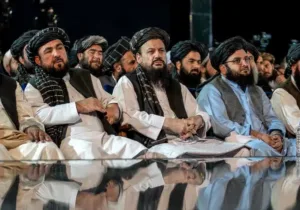On Sunday, October 7, 2001, the US military began a devastating assault on Afghanistan following the 9/11 attacks on New York and Washington, DC. The Taliban leader, Mullah Muhammed Omar, fled Kunduz on December 7, and at that point all of the major cities of Afghanistan—Kandahar, Jalalabad, Herat, Kabul, Mazar-e-Sharif—had fallen to coalition forces. Although considerable security operations continued, such as at Tora Bora and later the “Anaconda” campaign, the hot war was effectively over by Christmas.
Who could have thought that this month we would be reflecting on 20 years of war in Afghanistan? As the twentieth anniversary of 9/11 looms, President Joe Biden has rushed to pull US troops out of Afghanistan. What are we to make of all of this?
Taking a step back, it is noteworthy that the initial US demand was that the Taliban turn over the leadership of al-Qaeda—Osama bin Laden. Moreover, the original war aim was not the reconstruction, or better construction, of a twenty-first-century Afghanistan, but rather to bring to justice those responsible for the 9/11 attacks. This was the argument made by President George W. Bush on September 20, 2001: “Our grief has turned to anger and anger to resolution. Whether we bring our enemies to justice or bring justice to our enemies, justice will be done.”
Bush could have said, “Our grief has turned to anger and our anger to hatred. We will revenge ourselves on our enemies. We will rain down wrath until we have destroyed them, their families.” Yet, he did not do so.
This measured response lasted throughout the war, as evidenced by the fact that for the next several years the US deployment to rugged Afghanistan (population over 20 million) was about equal to the size of the NATO deployment to provide order for Kosovo’s 1.2 million inhabitants following the 1999 intervention there.
It is doubtful that anyone in the West expected that the US and its allies would still have troops in Afghanistan today, 20 years after 9/11. One reason for this is that war aims, political expectations, and the international context have all evolved in ways beyond the power of the US military. It took only a short time for an expansive international agenda to take over the political discourse about Afghanistan with talk of rebuilding and reconstruction. Meanwhile, the Afghan theater was complicated by its connections to its immediate neighbors (Pakistan and Iran), as well as the attention and expense the US engendered when it invaded Iraq in early 2003. More specifically, the Afghan war provides a case in point on the limitations that military power, on its own, faces when pursuing political objectives.
First, the US experience in Afghanistan demonstrates that, in pursuing national objectives, military power is just one element of national power. In the short term, the US and its allies sent the Taliban and al-Qaeda fleeing, and there has not been a true strategic threat by these forces against the US homeland again. Nonetheless, when one considers the intersection of evolving US war aims to include Afghanistan’s political and economic development, with other elements of national power, it is clear that military force had its limitations.
Certainly, the other features of national power were on display in the Afghanistan context. Strategists call those elements of national power DIME (diplomacy, information, military, economic forms of power). The US led, but could not control, the political and military apparatuses of dozens of other countries involved with either the International Security Assistance Force (ISAF)-military or United Nations-sponsored civilian reconstruction and development enterprises. It required a high level of diplomatic expertise and effort to deal with allies, such as those who would not deploy their troops with weapons (e.g., Germany) as well as to deal with neighboring countries, most notably Pakistan, where much of al-Qaeda and the Taliban’s senior leadership eventually holed up. The diminutive size of the US Department of State and USAID’s workforce ready to deploy to the Afghan theater and the paucity of individuals with language and cultural expertise, with the exception of US Ambassador Zalmay Khalilzad (who is of Pashtun descent, like the majority of the Taliban), are examples of how in this theater the US had significant diplomatic weaknesses that could not be addressed solely by a powerful military.
Over time, some of these weaknesses, such as a lack of cultural sensitivity and language abilities, provided resurgent anti-coalition forces with another tool in information operations. The US was poorly prepared to wage a war of ideas against the enemy on the ground, whereas the Taliban became increasingly sophisticated at trumpeting its tactical successes as well as broadcasting, often by radio, collateral damage by “Crusader” forces, often associating coalition forces with the hated Russian invaders of the 1980s. Moreover, as David Kilcullen observed in The Accidental Guerrilla, al-Qaeda was able to tie the local struggle of Afghans to wider struggles of Muslims against the imperialist West, and had affiliates pledge solidarity from the Philippines to North Africa. This was a strategic information blow to the US and its allies.
Finally, despite the massive economic resources of the US and its allies, the application of economic power was extremely difficult in the Afghan theater. On the one hand, coercive tools of statecraft, such as economic sanctions, really did not play a role before or after the Taliban’s fall. The pre-modern economic structure of agrarian Afghanistan and dramatically different cultural norms regarding money and finance meant that the US and its allies would invest billions of dollars in infrastructure and education without seeing real gains in security in many parts of the country.
In short, although the US and its allies won important military successes in 2001–02, the long-term insecurity in Afghanistan and its region was resistant to solutions that were satisfactory to Washington and its allies. Moreover, the weak application of other sources of national power was a constraint on any notion of settlement or success.
Second, the US military of 2001 was not be prepared or equipped for the conflict at hand. It may be hard to remember it now, but at the time the US military planned to shutter its B-1 bombers and A-10 close support aircraft, and it was debating how much to invest in the latest tank and fighter jet aircraft. The US military was largely a conventional force, and the majority of its deployments since Vietnam had been conventional in nature. Indeed, in 2001 the US was only a decade beyond the collapse of the Soviet Union, and the doctrine and missions of the 1990s emphasized traditional great power threats (e.g., Russia, China), containing regional rogues states (e.g., Iran, North Korea), and armed humanitarian intervention. Despite a number of terrorist attacks (e.g., Khobar Towers, USS Cole), training and weapons systems for the vast majority of the US military remained conventional in almost every way.
The 9/11 attacks altered the strategic landscape, but, to paraphrase Secretary Donald Rumsfeld, one goes to war with the military one has. The equipment required for the rigorous conditions of Afghanistan was far different from that associated with the conventional battlefields of Europe or the Korean Peninsula. The evolving conditions of warfare required, over time, investments in heavily armored transportation, military supplies for the primitive Afghan National Army and police force(s), and training for US military personnel deploying to a dramatically alien environment.
When it comes to military training and doctrine, the US changed course in its approach to Afghanistan, having to change its mindset from that of liberators punishing the “evil” Taliban and al-Qaeda to stabilization and reconstruction operations that were nothing short of nation-building. At the same time, US military leadership transitioned the strategic approach, over time, from counter-terrorism to counter-insurgency, with fluctuating rules of engagement as the Taliban resurged in tandem with disappointments in Iraq. By the mid-2000s, it had been over 30 years since the US had last engaged in systematic counter-insurgency operations; only a handful of the senior-most flag officers and US diplomats were in the service during the Vietnam era.
Of course, a strength of the US military is that, despite the turf and resource wars in Washington, the military nonetheless finds ways to adapt and overcome. It is not clear that any strategic approach could have built Afghanistan from the ground up after 2002, but in subsequent years many in the field met the struggles with resolve, resiliency, and creativity. Tactics, tools, and even strategies ultimately evolved.
Third, the Afghanistan war demonstrates that military power is subordinate to political authorities, who are responding to the political climate and public opinion at home. In the case of the US, this means that public and international opinion, the press, and the partisan wrangling of our electoral system all influence the direction of US national security and foreign policy. Following the 9/11 attacks, it appeared that the world community would rally around the US, and NATO members invoked the collective defense provision found in Article V of the NATO charter. There seemed to be a high level of support for robust action to punish the terrorists and deter future terrorist attacks.
The US chose to lead a coalition in Afghanistan, and it quickly became apparent that the world community was embracing a much wider strategic agenda. In January 2002, the international donors’ conference in Tokyo embraced a preliminary report—drafted by the UN Development Program, World Bank, and Asian Development Bank—calling for $15 billion for “recovery and reconstruction” in Afghanistan over the subsequent decade. This demonstrates, on the one hand, tremendous goodwill toward the Afghan people, but it also suggests that the punish-and-deter vision of October 2001 had been superseded by a dramatic, costly commitment to nation-building. For the next 15 years, there would continue to be significant investment in reconstruction and recovery in Afghanistan, from roads to courts to schools, while at the same time a low-intensity conflict was raging.
At the same time, US military action was under the constant scrutiny of US-based and international media, who broadcasted in real-time the plight of Afghan civilians and many of the challenges on the ground. This news coverage, with a particular focus at times on civilian casualties, influenced strategic decisions by the military and its partners, in addition to the views of the White House and Congress. Over time, larger and larger segments of the US population, and the Democratic opposition in particular (until 2009), questioned the strategy, efficacy, and even intentions of the commander-in-chief and the military in the field. The Afghan war was overshadowed by the conflict in Iraq, but the harsh criticism of that war became a wider assault on Defense Department leadership, as well as strategies and operations in the field.
Frankly, it is unclear what the US military could have done differently in Afghanistan after 9/11 when it comes to democratic oversight, the role of the media, and public opinion. The Afghanistan war became entangled in many ways with the far less popular Iraq war; the military in Afghanistan had the limitations of materiel and inexperience noted earlier in this essay. Nevertheless, the tremendous efforts by the US and coalition partners to fight discriminately, limit collateral damage, advance a reconstruction agenda in spite of tremendous obstacles, and achieve the mission commanders spelled out (whether counter-terrorism or counter-insurgency) in a complicated, dynamic battlespace are worthy of the respect of history.
What about some form of “reconciliation” with the Taliban? I continue to believe that what I wrote a decade ago remains true. In my book, Ending Wars Well (Yale University Press, 2012), I concluded:
If there is to be conciliation it will not be due to a moral epiphany among the Taliban or tribal leaders nor to appeals to justice and brotherhood. Any arrangement that brings the Taliban in “from the cold” must be based on a reappraisal of their interests. That appraisal might be based on major military victories that lead the Taliban and its tribal allies, stricken and on the verge of collapse, to switch sides.
At the time of that writing (late 2010), there was an effort to negotiate with elements of the Taliban at a national peace event (loya jirga). The top Taliban representative was assassinated en route by factions within the Taliban. That dogged determination made me believe then, and now, that unless the Taliban truly was on the verge of defeat, they would not give up.
So, today, as we approach the 20-year mark of 9/11, it may be the case that US leadership has given some Afghans the best chance possible for them to win their own fight against those, like the Taliban, who would use violence to achieve their goal of a retrograde Islamist society. They have had 20 years of security and humanitarian assistance. But American presidents—as all have done—have to ask whether or not it is worth the life of another American citizen to try to bolster the floundering society of Afghanistan. Do our leaders, in 2021, see a direct threat to the US in Kandahar? Can they make the case to parents and spouses that we need to keep Marines and soldiers in harm’s way in far-off Central Asia? We seem to have come to a moment in the arc of history where the logical next step is to remain vigilant to contain the violence within Afghanistan and the region while largely allowing Afghan citizens to manage their own affairs. Unfortunately, as Reinhold Niebuhr would remind us, this shows the dramatic limitations of our own power and desires in a fallen world.







 Sponsor a student for Christianity & National Security 2024
Sponsor a student for Christianity & National Security 2024